|
The Moors
Run
Yorkshire
Area MVT Annual Crank Down by Chris Smyth
|
Question:
What have Smugglers, Captain Cook, Frankenstein and one of the first
German planes to be shot down over British soil in WWII got in common?
Answer:
another stupendous Yorkshire Area Crank Down running through more
stunning scenery.
As members fell into their sleeping bags, on the second evening,
camped on the cliff tops over looking the North Sea you immediately
have a clue that this year the club had turned back to the North
Yorkshire Moors in place of the Dales in the previous year. As we sank
into our pillows we could all look back at a blissful first days
run…….
|
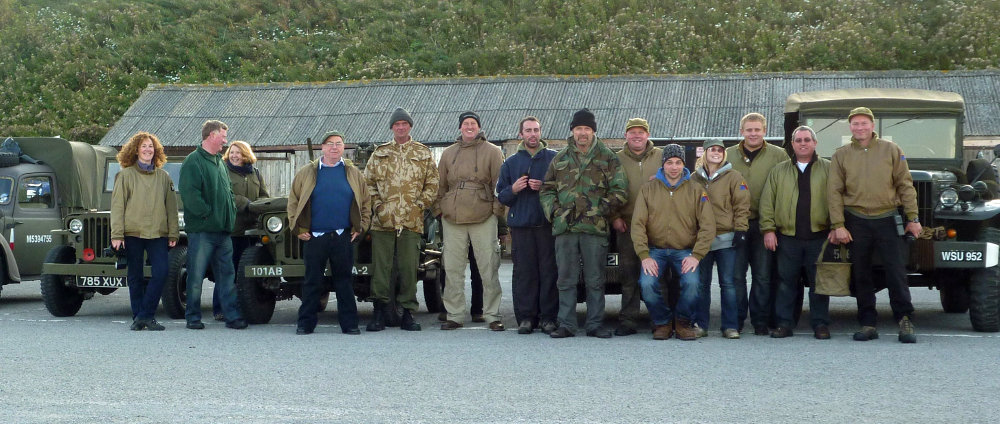 |
| In
fact, most of the crew had also spent the previous night at Nev
Johnson’s farm just south of Pocklington, in the Vale of York. Apart
from enjoying, once again, Nev’s superb hospitality it was also
fascinating to hear his boyhood stories of RAF Melbourne, a Bomber
Command airfield immediately adjacent to his farm.
The Saturday
morning dawned fine and clear, although with a very heavy dew, and it
took some time for both tents and members to dry out from the night
before. Simon Roberts who had organised the weekend had found the
perfect jumping off point for the rally. Soon the 13 Jeeps, one Dodge
and several Land Rovers were summoned to life by Simon’s shrill
whistle and with engines straining to be underway the signal was given
and the convoy raced away from the start line.
|
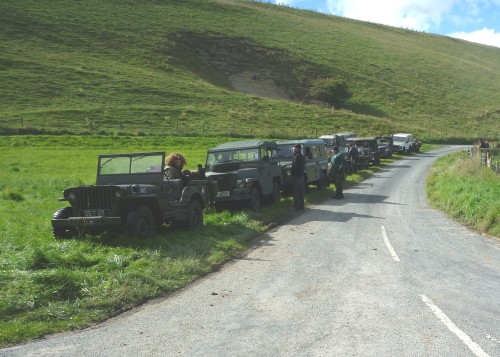 |
The
first stretch, rattling though the local lanes, made it easy to see
why so many WWII Bomber Airfields were sited on the wide flat Vale to
the east of York. Although this low lying, but beautiful, landscape,
was to have little in common to the hillier routes ahead, what these
roads already shared with the weekend to come was the virtual absence
of traffic.
It may be
hard for those from elsewhere to appreciate that Yorkshire’s varied
landscape is so broad that with carefully planning modern cars can be
hard to find. In these early stages of the drive it therefore made it
even easier to visualise these same byways being awash with military
vehicles as the Bomber campaign was at its peak.
My good
fortune, and Val’s, having organised the two previous outings in The
Yorkshire Dales in alternate years, was to simply tuck our jeep into
the middle of the line and let Simon do all the work.
|
| I
say all the work however; YMVT’s now slick convoy operation belied
the attention to detail under the guise of an easy going and friendly
exterior. The clubs powerful radios and other willing volunteers made
commanding the operation a smooth task; on point in Simon’s command
Jeep were Mike and Sharon. Sharon, a professional photographer soon
became a familiar sight on the weekend look back down the line of
bouncing vehicles with her powerful camera and hair blowing with
abandon in the slipstream.
Brian
Slingsby, our popular Chairman, held the centre from his Dodge Command
Car, a vehicle entirely fitting his status whilst Dave Reape acted as
an experienced tail end Charlie ready to mop up any stragglers. There
was never any need to fret, with the tight radio net. There were other
sets in the group too, and all were kept in great order.
|
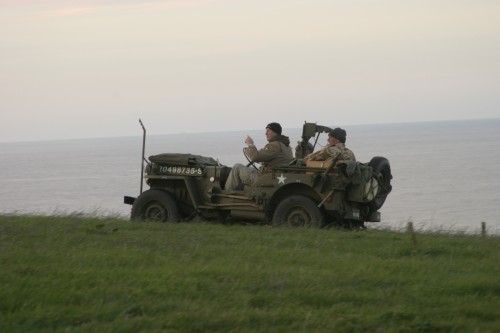 |
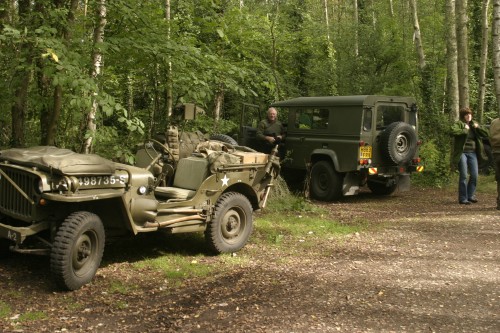 |
| I
said that there were some 13 or so Jeeps and Land Rovers however,
there was at least one oddity, not counting Brian’s Command car.
Something that looked like a sand buggy was ahead of our Jeep for the
first part of the tour. This was Colin Scott’s LSV (light strike
vehicle), a first class replica that he had entirely built from
scratch. It looked great. However, with its completely open tubular
structure, I was glad of the relative comfort of our Ford GPW. |
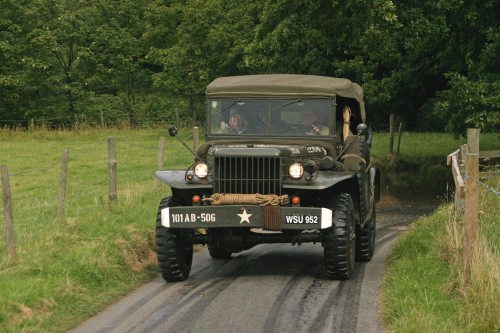 |
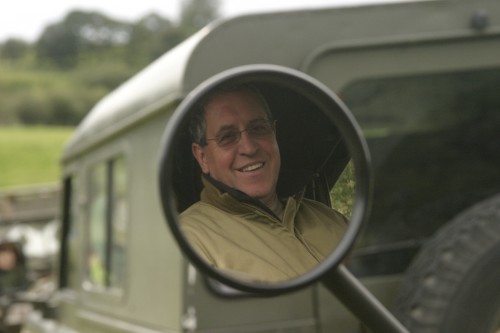 |
| Soon,
the group crossed the York/Hull road and at last the lanes began to
climb into the Yorkshire Wolds. Like the Downs in the South of England
the soft lines of the Yorkshire Wolds are formed from chalk and
limestone. High planes are cut by deep dry fissures that were formed
in the Ice Age as melt water from a great lake north of the area dug
the valleys through the permafrost as it cascaded into the Humber
beyond. If you haven’t visited these Wolds it is hard to imagine
their expanse. This beautiful rolling countryside must be one of the
‘Breadbaskets’ of England with rich fields of cereal crops
extending for miles in all directions. |
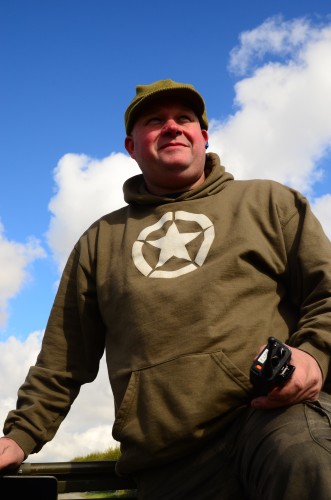 |
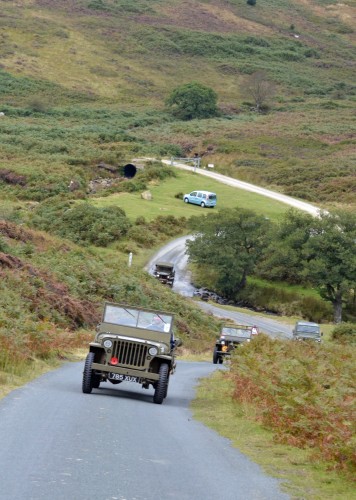 |
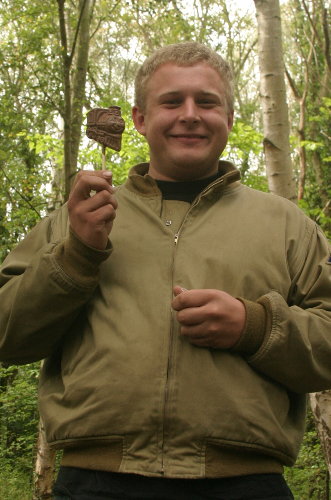 |
| Gaining
the high ground north of Wartner the convoy first traversed the
rolling Wolds hill tops with splendid views in all directions, aided
by a lovely autumn day. Then, north of Fridaythorpe our small band
plunged off the high plains into one of the dry valleys below to
continue the drive forward. Finally, with a breakout across the Malton
road, Scarborough was soon on our right flank with our first sight of
the North Yorks Moors rearing ahead of us. Soon we paused for lunch; a
fair ale house surprised by our sudden descent had no food to offer
though was happy for our group to buy fish and chips from a nearby
chippy, the fresh fish landed just that morning, and enjoy them in the
landlord’s friendly bar. |
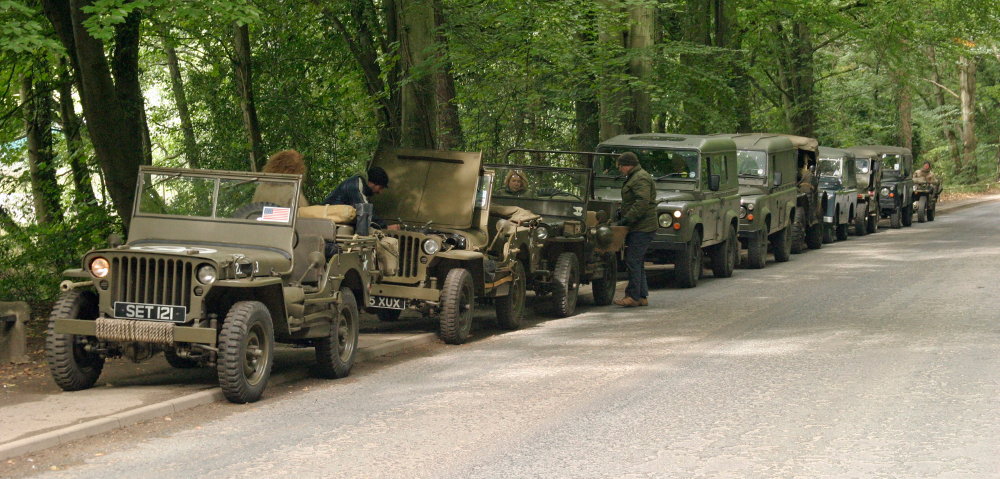 |
| We
soon rallied, and climbing again entered the dark North Riding Forrest
on the edge of the moors. On through Harwood Dale, tantalising
glimpses of the sea winked at us through the trees and vales as we now
tracked the coast north.
The end of
the first day was not far away now and as we approached the coast we
paused just short of Boggle Hole. Here, an impromptu briefing for all
was held over the bonnet of a Jeep. Simon, in gathering intelligence
for our push to the north was able to tell us how RAF pilot Peter
Townsend, flying a Hawker Hurricane of 43 Squadron, downed Heinkel He
111, Werke Nummer 3232, of KG 26, piloted by Hermann Wilms, which
crash-landed near Bannial Flat farm, Whitby. This was the first German
aircraft downed on English soil since a Gotha bomber at Harrietsham,
Kent, in 1918.
|
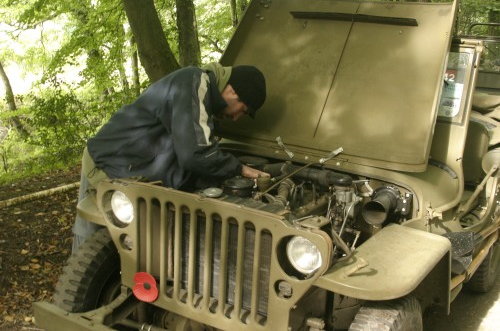 |
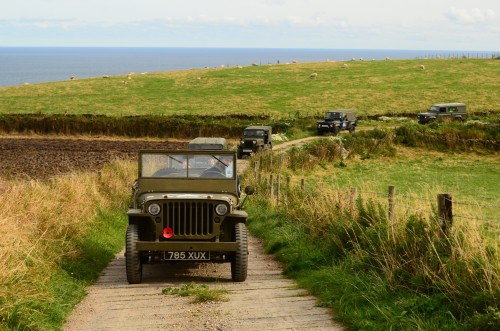 |
| Some
more fine deep and twisting lanes behind the cliffs and bays soon
brought us to our leaguer for the night. High on the cliff top
overlooking the spectacular Robin Hoods Bay we rolled into a simple
campsite and pitched our bivvies on whatever piece of flat land could
be found. Hand brakes were checked that night; it appeared that had a
Jeep rolled away down the slope it would soon have been dashed on the
rocks below.
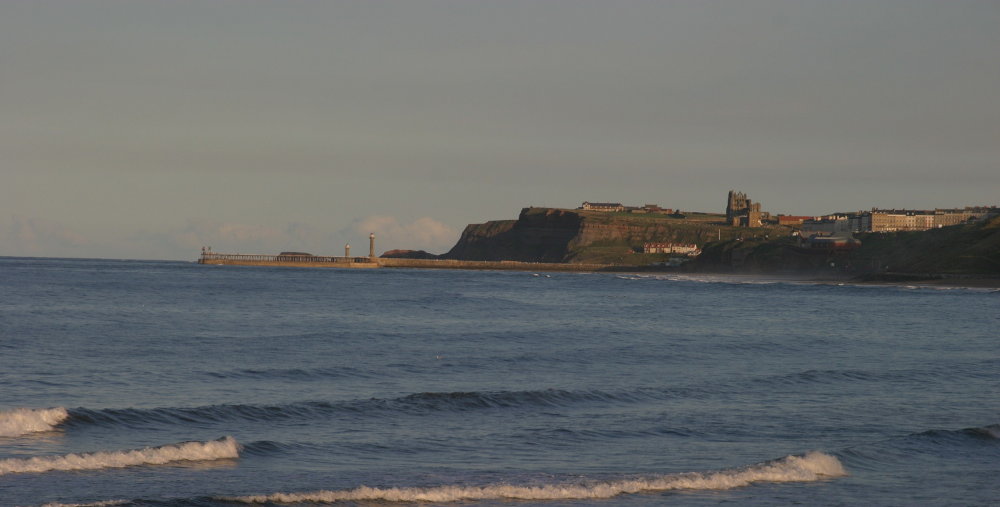
Once dug in,
parties we arranged for a recce into Robin Hoods Bay itself. The
‘infantry’ took a direct line dropping off the cliffs and entering
the town from a deserted rail track in the north. The smaller
‘motorised’ group covered the west flank and soon both groups had
rejoined to make head quarters in the Bay Horse hotel at the top of
the main street and discuss tactics over a hearty dinner.
|
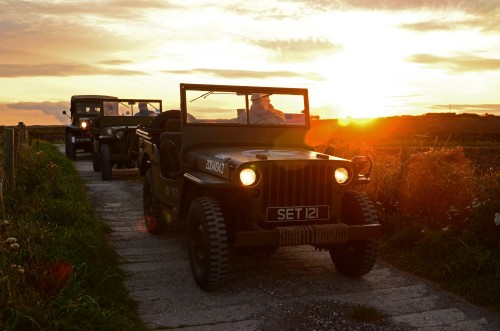 |
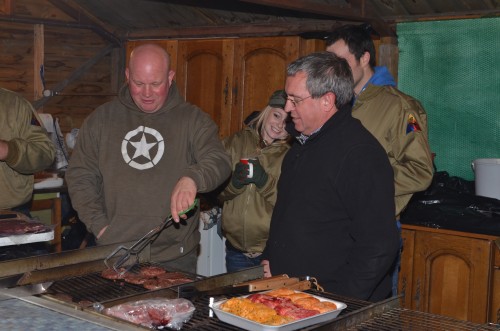 |
| Tactics
demanded a march down the narrow winding street, to another pub
directly overlooking the beach. Robin Hoods Bay is one of the gems of
the Yorkshire Coast Line; a stunningly attractive remote fishing
village it tumbles down the hillside to the very shore, imitated only
by the like of Polperro and Lynmouth. Its remoteness made it an ideal
place for smugglers and forsaking a pint or two Simon, Mike and Sharon
couldn’t avoid exploring the dank smugglers tunnel that ran from the
shoreline under the town.
Finally, the
retreat out of the town was made up the steep hills back to the camp
sight and a final glass of wine or two around Denis’s roaring
brazier fuelled by bleached dry driftwood.
|
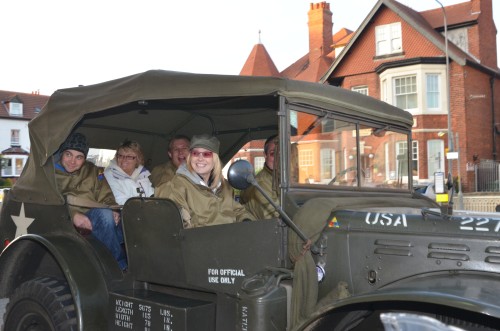 |
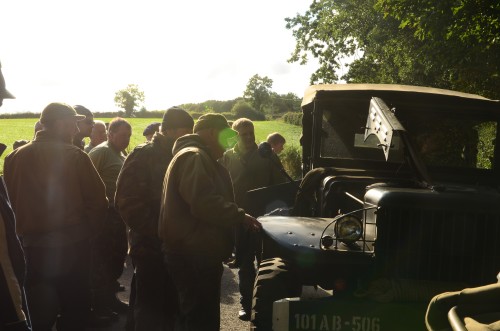 |
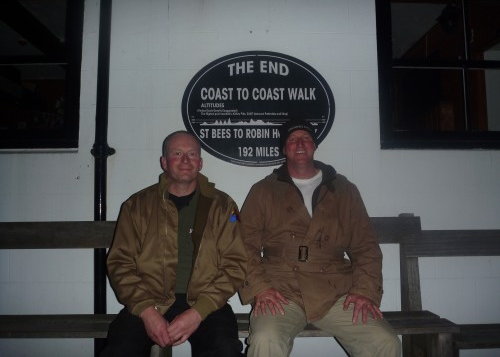 |
I
am told, by those who were lucky enough to see it, that the next
morning’s sunrise was spectacular. Rising from a flat calm North Sea
it lit up a brilliant blue sky and Robin Hoods Bay and despite our
exposed position the grass was hardly wet from the night before and
our tents soon dried.
Although,
many vehicle events around the UK this year have been ruined by bad
weather, the luck of the Yorkshire MVT held out again. From a fine
Crank Up to a ‘flag cracking’ weekend at out main ‘Wheels and
Wings Jubilee Show’ at the Yorkshire Air Museum it was clear that
our Crank Down weekend was now set fair despite storms again already
raging in the south.
|
| Breakfast
was served around Denis’s brazier and the rear of Brian’s Command
car. The tailboard of the Dodge made an excellent camp kitchen with
lashings of club bacon to hand. Unfortunately the front end of
Brian’s Dodge was not in such good shape. The afternoon before a
leak, at the head of the radiator, had led to water being blown back
over the engine by the fan. In turn this had soaked the electrics and
the old girl was soon running rough, and at times not running at all.
Reaching the camp site the night before had presented a wonderful
opportunity to sort out the Dodge problems. However, as one wag
observed, why do something today that you can put off until tomorrow?
Consequently, at the allotted start time the Dodge refused to budge
and only after an hour’s delay with plugs, leads, caps and points
flying in all directions did she finally cough into life.
|
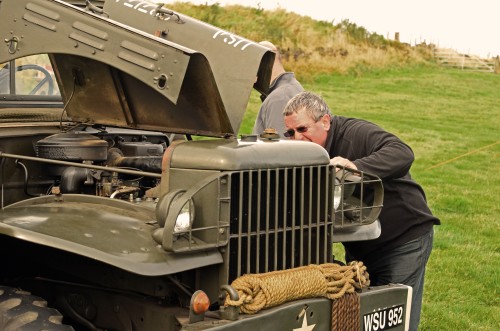 |
The
delayed start meant a brisk beginning to the Sunday with the convoy
charging away from the cliffs and towards nearby Whitby. Whitby is
another fine Yorkshire seaside town. It was here in this natural
harbour that spawned Captain Cook and his ship, the Endeavour a flat
bottomed collier, that led to the discovery of the New World. Looking
down at the port, the eyes are drawn at the same time to the looming
ruins of Whitby Abbey high on the cliffs above.
The
Benedictine Abbey, a birthplace of Christianity in England, was the
site for the Synod of Whitby, in 664 AD, at which the church adopted
the Roman calculation of Easter. In 1914, Whitby Abbey was shelled by
German battlecruisers Von der Tann and Derfflinger, aiming for the
signal post on the end of the headland. And even from our Jeeps it was
easy to see how the harrowing dark ruins of the Abbey were the
inspiration for Bram Stoker's Dracula.
|
| Turning
inland from Whitby we raced inland to Grosmont, once an iron ore town,
this is now the northern end of the North Yorks Moors Railway, one of
the foremost preserved steam railways in the land.
A brief rest
here enabled us to stroll along the platforms in the sun and watch
well dressed passengers board the Pullman dinning cars for their
Sunday lunch touring down through the North Yorks Moors.
On leaving
Grosmont our ascent to the high ground began by charging through a
spectacular ford across the river Esk. Clint Lord who had joined us
with his Jeep all the way from Devon, was quickly rewarded for his
enthusiasm in speeding through the torrent by then firing on three
cylinders.
|
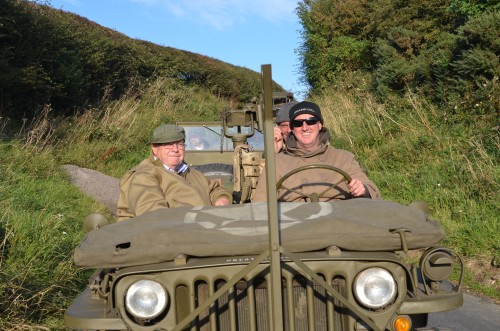 |
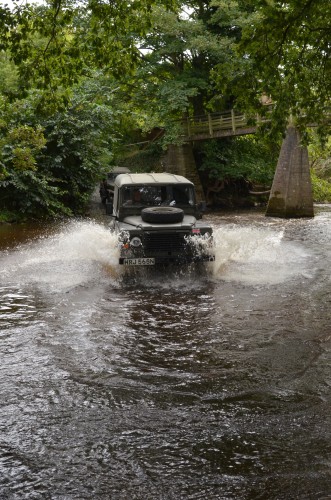 |
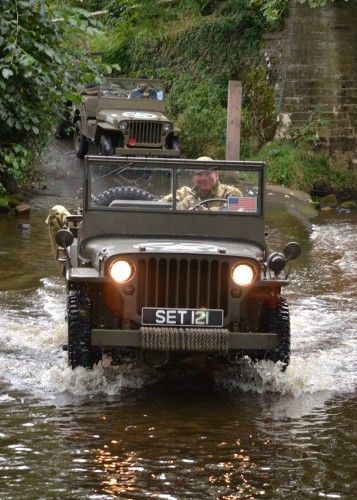 |
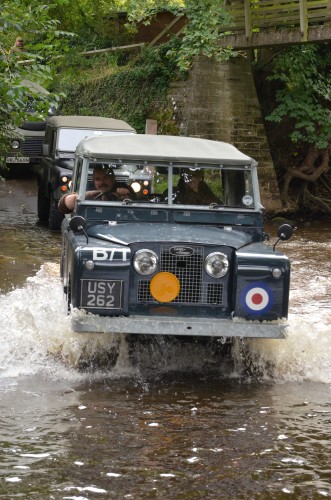 |
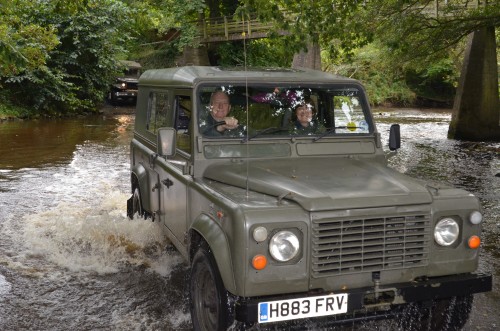 |
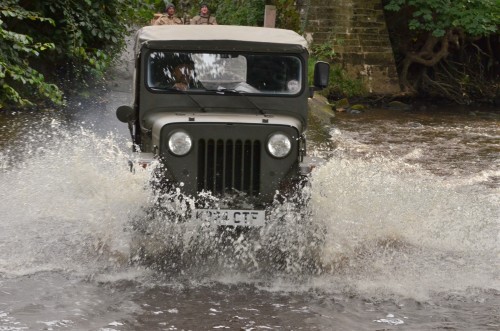 |
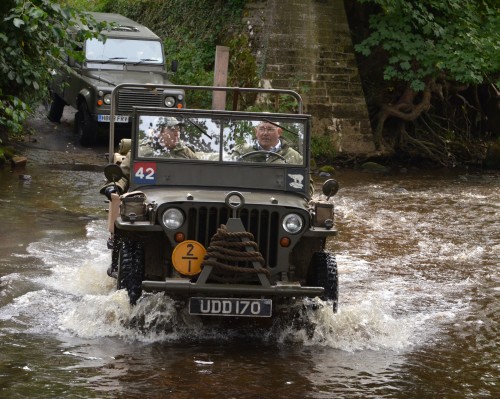 |
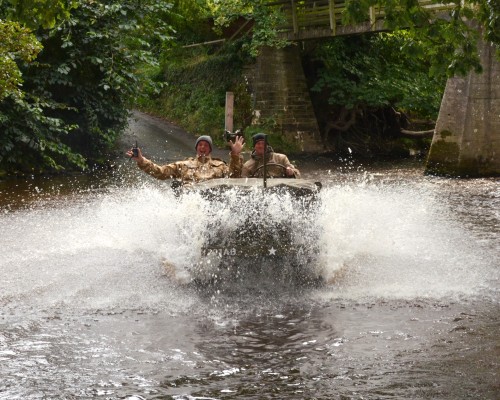 |
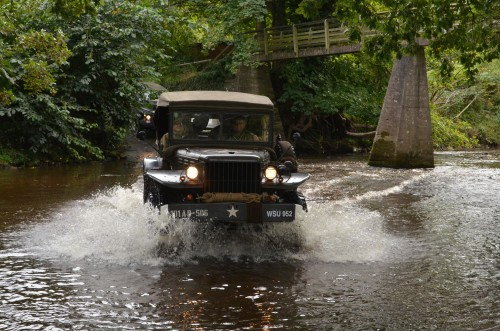 |
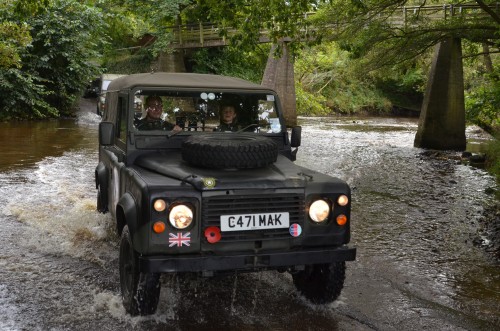 |
A
steady climb led us back onto the high North Yorks Moors with the
heather just beginning to turn to a deep purple. Perhaps the best road
of the weekend led us across the desolate Wheeldale Moor; a fine
single track road traversing to the south for many miles. The two
other becks, easily forded on this road, would probably have been
impassable to all traffic as soon as the next day as torrential rain
tracked north.
Dropping into Newton Dale, and then to Pickering, we were all too soon
off the moors and thinking of the road home. Here we said some
goodbyes, including to Colin and Elizabeth Parr who had driven all the
way from Southampton in their Land Rover 110 to take part in our
weekend once again.
The remains of
the party continued south through the green lush foothills to the west
of the Yorkshire Wolds and finally to the last farewells back at
Nev’s.
If this account sounds lyrical, well yes it should be. Once again the
Yorkshire MVT and guests had done what should be done with our
vehicles and driven them on the sort of roads that would have been
familiar 70 years ago. Not only that; blessed with lovely weather we
had once again sought out some of the finest and most remote lanes in
some of the most picturesque places in the County. We are already
looking forward to next year’s autumn run; our fifth of the series
and it will be back to the Yorkshire Dales……….
All photos © Sharon Annot and Mike Hemingway
|
|